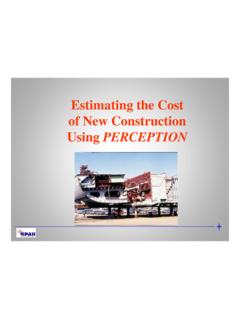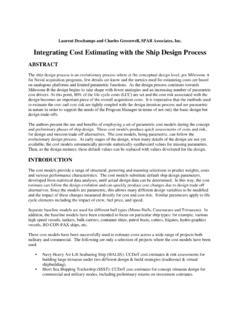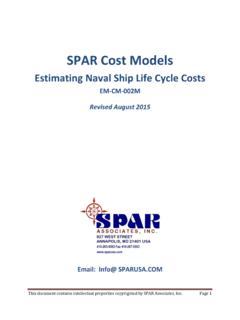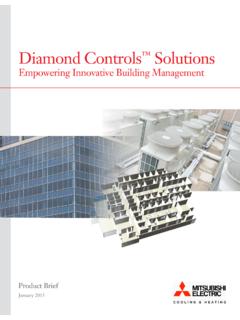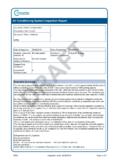Transcription of SPAR’s Estimating Cost - Spar Associates
1 SPAR s Estimating cost Models The SPAR cost Models are pre-developed cost models of specific hull forms and are organized with generic CERs already installed and ready to use. These cost models can be run outside SPAR s ESTI-MATE database system or fully integrated within ESTI-MATE. SPAR s cost models were developed to support early concept and preliminary stages of ship design. The cost models permit quick assessments of costs, risk, and design/mission trade-off and build strategy alternatives. There are options for Life Cycle cost (LCC) Estimating Too. These cost models are parametric in nature, although they provide a granularity of cost details down to approximately the SWBS level 3.
2 Various versions provide construction cost estimates for lead ship, follow ships and non-recurring design and engineering efforts for different hull forms and mission requirements. The cost models substitute default ship design parameters developed from statistical data analyses until actual design data can be determined. In this way, the cost estimate can follow the design evolution and can produce quickly cost changes due to design trade off alternatives. The models provide a range of structural and powering selections, as well as a wide range of other ship systems and equipment choices to predict costs and various performance characteristics.
3 Costs are generated at relatively low levels of detail and summed according to an abbreviated Ships Work Breakdown Structure (SWBS). Reports are available in various levels of detail, both tabular and graphical. Detail cost Estimate Reports Construction Totals Non-Recurring Totals Non-Recurring & Construction Totals Summary cost Estimate Reports The models estimate both recurring and non-recurring costs Options for Life Cycle Costs (LCC) Non-Non-Non-Recurring cost Estimate Lead Ship cost Estimate Lead Ship Material cost Estimate Summary Non-Recurring & Lead Ship cost Estimate Summary Non-Recurring & Lead Ship cost Estimate Summary Non-Recurring Costs Rates & Escalation Productivity Factors SWBS Summary Costs Summary cost Risk The models generate average ship costs for multiple-ship construction programs.
4 Defining Ship Characteristics Basic design information (ship characteristics) is required as input into the model. This includes dimensional and structural data, powering specifications, and details of special equipment and functional areas of the ship. The models also can generate some information not provided by the user from sets of default assumptions and functional relationships. NOTE: Any default values used by the model should not be regarded as having been validated by any formal naval architectural or engineering review process. Ship Characteristics Data Entry Worksheet Defining Structural Components with Material Codes Wide Selection of Type Structural Materials to Assign to Structural Components Wide Selection of Type Propulsion & Electric Generation Systems Electric Systems: Electrical Generation Cable & Hangers Appliances & Electrical Components Lighting Electronics: Exterior & Interior Communications Navigation Systems Miscellaneous Electronics Wide Selection of Ship Systems & Support Services from which to Choose: Auxiliary Systems.
5 hvac Engine Room Piping (fuel, Lube, Cooling, Exhaust) Bilge & Ballast Systems Habitation Piping (Potable & Sanitary) Fire Protection Systems Cargo Piping Systems Outfit Systems: Exterior & Interior Coating General Hull Outfit (Rails, Stanchions, Davits, Insulation, etc.) Rescue & Life Saving Systems Cranes, Lifts & Elevators Machinery Space Outfit Superstructure Outfit Accommodation Outfit Fire Fighting & Pollution Control Systems Hydrographic Research Equipment Technical Support: Planning & Program Management Production Engineering Support Tests & Inspections Contract Administration Production Support: Material Control Quality Control Supervision Production Services All CERs can be modified, added or deleted by the user.
6 cost Estimating Relationships The cost Estimating relationships (CERs) used in the cost models apply to a generic mid-size commercial shipyard having reasonably productive manufacturing and assembly facilities, and technical and management competence. The CERs are based upon a comprehensive analysis of shipbuilding costs gathered from SPAR s working experience with a variety of shipyards, large and small, commercial and naval contractors. The generic CERS are based upon a notional modern mid-size commercial shipbuilding facility having the following general operating characteristics: a) Current technology CAD and resource planning and management systems b) Moderate levels of pre-outfitted hull block and module construction c) N/C plasma plate cutting d) Automated panel line e) Large hull block assembly hall f) Automated shot blast and painting facilities g) Steel manufacturing capacity of approximately 20,000 MTONs (steel or equivalent) per annum.
7 Productivity Factors Productivity factors may be applied to the generic commercial shipbuilding CERs. They are based upon a cross-industry analysis of cost performance data collected from various sources. Separate factors may be applied for structural work, outfit and technical. Material costs also can vary, depending on the type of shipyard. Mil-Spec materials are generally regarded as being of higher standards, such as for added shock protection. The cost models provide special features for additional cost savings build strategies 31 Modules can be developed in a wide variety of ways: Outfit and equipment modules, Hull assembly blocks, Outfitted hull blocks, and Outfitted panel assemblies 32 Typical Hull Modular Blocks The cost models offer special options for developing cost estimates that reflect significant savings potential from extended modularization of design and construction 34 On unit outfit may be as small as a single piece of equipment mounted on its foundation and ready to install on panel, on block or on board.
8 Or, on unit outfit can be a complex assembly of equipment, piping, electrical and other systems all pre-mounted on a support structure. Expanded use of modules carry the concept of early stage construction cost savings even further. 35 Accommodation Module Turbocharger Lube Oil Module Alfa Laval Module Lube Oil w/Pumps Module Westfalia Separator Module 36 Hydrophore Module Sewage Treatment Module Refrigeration Compressor Module cost Escalation Material costs are summarized and escalated to a common, base year value. All materials and equipment escalation and forecast for the future using commodity-based escalation tables that are updated on a regular basis.
9 Contingencies The models allow for defined contingency costs for the following: Systems not yet defined or so far left out of the details; Limited owner changes; and Any design margin traditionally allocated for a preliminary design. cost Risk The cost models generate estimates of cost risk. The cost models break out cost risk into five primary categories: 1. The production cost risk for labor and material. 2. cost risk of rework due to immature engineering. 3. The inexperience cost risk that may be associated with a shipyard that has not built this type of ship before. 4. The cost risk when detail design, engineering and planning cannot complete quality work in time to meet production schedules.
10 5. The cost risk due to production schedules are so short that excessive manpower must be applied to meet a planned delivery. Estimating Manpower Requirements The cost models automatically generate estimated engineering and shipyard production manpower requirements. This is a good cross-check on the defined schedule and the estimated labor hours. Design Trade-Off Studies The model can quickly generate costs across a wide range of ship design parameters, materials alternatives and propulsion system options. The model can quickly compare the cost of various materials and their weight characteristics.
